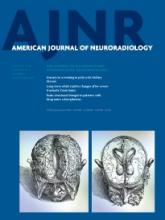Index by author
Pirpamer, L.
- BrainOpen AccessDecreased T1 Contrast between Gray Matter and Normal-Appearing White Matter in CADASILF. De Guio, S. Reyes, M. Duering, L. Pirpamer, H. Chabriat and E. JouventAmerican Journal of Neuroradiology January 2014, 35 (1) 72-76; DOI: https://doi.org/10.3174/ajnr.A3639
Pittock, S.J.
- FELLOWS' JOURNAL CLUBBrainYou have accessMRI Findings in Autoimmune Voltage-Gated Potassium Channel Complex Encephalitis with Seizures: One Potential Etiology for Mesial Temporal SclerosisA.L. Kotsenas, R.E. Watson, S.J. Pittock, J.W. Britton, S.L. Hoye, A.M.L. Quek, C. Shin and C.J. KleinAmerican Journal of Neuroradiology January 2014, 35 (1) 84-89; DOI: https://doi.org/10.3174/ajnr.A3633
Voltage-gated potassium channel complex encephalitis is a common form of autoimmune encephalitis presenting with intractable seizures that may respond to immunotherapy. These authors reviewed the imaging findings in 42 such patients and the most common abnormalities noted were enlargement, T2 hyperintensity, contrast enhancement, and restricted diffusion in the mesial temporal lobes with subsequent development of hippocampal atrophy. Because the disease can be confirmed easily by the presence of voltage-gated potassium channel complex antibodies, these imaging findings should prompt serologic testing.
Politi, L.S.
- Head and Neck ImagingYou have accessDiffusion-Weighted Imaging of Orbital Masses: Multi-Institutional Data Support a 2-ADC Threshold Model to Categorize Lesions as Benign, Malignant, or IndeterminateA.R. Sepahdari, L.S. Politi, V.K. Aakalu, H.J. Kim and A.A.K. Abdel RazekAmerican Journal of Neuroradiology January 2014, 35 (1) 170-175; DOI: https://doi.org/10.3174/ajnr.A3619
Puybasset, L.
- FELLOWS' JOURNAL CLUBBrainOpen AccessLong-Term White Matter Changes after Severe Traumatic Brain Injury: A 5-Year Prospective CohortJ. Dinkel, A. Drier, O. Khalilzadeh, V. Perlbarg, V. Czernecki, R. Gupta, F. Gomas, P. Sanchez, D. Dormont, D. Galanaud, R.D. Stevens, L. Puybasset and for NICER (Neuro Imaging for Coma Emergence and Recovery) ConsortiumAmerican Journal of Neuroradiology January 2014, 35 (1) 23-29; DOI: https://doi.org/10.3174/ajnr.A3616
The authors used DTI to study posttraumatic white matter changes over a 5-year period. Thirteen patients with severe injuries acutely showed significant fractional anisotropy decreases in the corpus callosum and corona radiata when compared with controls. These abnormalities progressed at 2 years and then remained stable until 5 years. The DTI abnormalities correlated with sequelae such as amnesia, aphasia, and dyspraxia.
Qian, Y.
- NeurointerventionOpen AccessComputational Hemodynamics Analysis of Intracranial Aneurysms Treated with Flow Diverters: Correlation with Clinical OutcomesW. Chong, Y. Zhang, Y. Qian, L. Lai, G. Parker and K. MitchellAmerican Journal of Neuroradiology January 2014, 35 (1) 136-142; DOI: https://doi.org/10.3174/ajnr.A3790
Quek, A.M.L.
- FELLOWS' JOURNAL CLUBBrainYou have accessMRI Findings in Autoimmune Voltage-Gated Potassium Channel Complex Encephalitis with Seizures: One Potential Etiology for Mesial Temporal SclerosisA.L. Kotsenas, R.E. Watson, S.J. Pittock, J.W. Britton, S.L. Hoye, A.M.L. Quek, C. Shin and C.J. KleinAmerican Journal of Neuroradiology January 2014, 35 (1) 84-89; DOI: https://doi.org/10.3174/ajnr.A3633
Voltage-gated potassium channel complex encephalitis is a common form of autoimmune encephalitis presenting with intractable seizures that may respond to immunotherapy. These authors reviewed the imaging findings in 42 such patients and the most common abnormalities noted were enlargement, T2 hyperintensity, contrast enhancement, and restricted diffusion in the mesial temporal lobes with subsequent development of hippocampal atrophy. Because the disease can be confirmed easily by the presence of voltage-gated potassium channel complex antibodies, these imaging findings should prompt serologic testing.
Quinn, M.P.
- BrainOpen AccessComparison of Multiecho Postprocessing Schemes for SWI with Use of Linear and Nonlinear Mask FunctionsM.P. Quinn, J.S. Gati, L.M. Klassen, A.W. Lin, J.R. Bird, S.E. Leung and R.S. MenonAmerican Journal of Neuroradiology January 2014, 35 (1) 38-44; DOI: https://doi.org/10.3174/ajnr.A3584
Ramanathan, M.
- EDITOR'S CHOICEBrainOpen AccessPrevalence of Radiologically Isolated Syndrome and White Matter Signal Abnormalities in Healthy Relatives of Patients with Multiple SclerosisT. Gabelic, D.P. Ramasamy, B. Weinstock-Guttman, J. Hagemeier, C. Kennedy, R. Melia, D. Hojnacki, M. Ramanathan and R. ZivadinovAmerican Journal of Neuroradiology January 2014, 35 (1) 106-112; DOI: https://doi.org/10.3174/ajnr.A3653
Healthy individuals who either had no relatives with multiple sclerosis or had a family history of it were studied and evaluated according the Okuda and Swanton criteria for radiologically isolated syndrome. These investigators found that the frequency of white matter signal abnormalities and radiologically isolated syndrome were higher in the healthy relatives of patients with multiple sclerosis compared with nonfamilial healthy control subjects. In healthy relatives of patients with MS, smoking and obesity also contributed to the presence of white matter lesions.
Ramasamy, D.P.
- EDITOR'S CHOICEBrainOpen AccessPrevalence of Radiologically Isolated Syndrome and White Matter Signal Abnormalities in Healthy Relatives of Patients with Multiple SclerosisT. Gabelic, D.P. Ramasamy, B. Weinstock-Guttman, J. Hagemeier, C. Kennedy, R. Melia, D. Hojnacki, M. Ramanathan and R. ZivadinovAmerican Journal of Neuroradiology January 2014, 35 (1) 106-112; DOI: https://doi.org/10.3174/ajnr.A3653
Healthy individuals who either had no relatives with multiple sclerosis or had a family history of it were studied and evaluated according the Okuda and Swanton criteria for radiologically isolated syndrome. These investigators found that the frequency of white matter signal abnormalities and radiologically isolated syndrome were higher in the healthy relatives of patients with multiple sclerosis compared with nonfamilial healthy control subjects. In healthy relatives of patients with MS, smoking and obesity also contributed to the presence of white matter lesions.
Razek, A.A.K. Abdel
- Head and Neck ImagingYou have accessDiffusion-Weighted Imaging of Orbital Masses: Multi-Institutional Data Support a 2-ADC Threshold Model to Categorize Lesions as Benign, Malignant, or IndeterminateA.R. Sepahdari, L.S. Politi, V.K. Aakalu, H.J. Kim and A.A.K. Abdel RazekAmerican Journal of Neuroradiology January 2014, 35 (1) 170-175; DOI: https://doi.org/10.3174/ajnr.A3619








